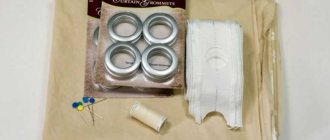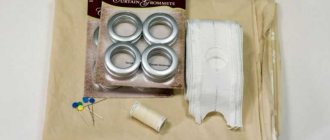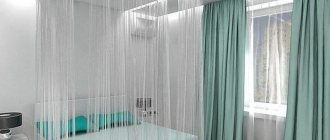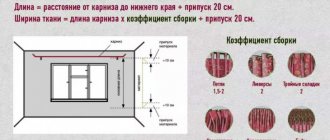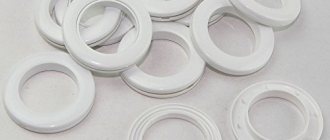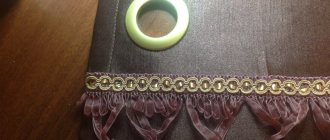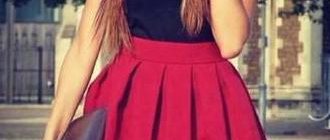Today there are many options for ready-made curtains and tulle. But sometimes windows have non-standard sizes and configurations. Or the design of the finished textile does not match the interior. It happens that the family budget does not allow you to buy expensive curtains with multi-layer draperies. For all these cases, there is one universal solution - individual tailoring. Doing the assembly yourself is not as difficult as it seems at first glance. But at the same time, you need to know how to correctly calculate the tulle and curtains for the window.
When calculating the width of the tulle, not only the length of the cornice is taken into account, but also the characteristics of the fabric
Window decoration with tulle: types of assembly
Folded tulle looks elegant and airy. Previously, each fold had to be done manually. Nowadays it is very easy to achieve a uniform and beautiful assembly - you need to buy a special tape for curtains.
Curtain tape allows you to neatly distribute folds across the entire width of the curtain
Curtain tape is a strip of fabric with cords running through it. By sewing the ribbon to the fabric and tightening the laces, you can make beautiful folds in the material. It is attached using special textile loops on the tape, which are attached to hooks. Transparent braid is bought for light transparent textures, such as: organza, mesh, in rare cases - crystalline, veil. The opaque tape is dense, on a cotton base, intended for curtains and opaque fabrics.
Transparent curtain tape is suitable for tulle curtains
Important! The opaque braid is made of natural cotton. When washed, it can shrink up to 10-15% of its length. Therefore, you need to take it with a reserve and iron it with an iron in the “Steam” mode before sewing.
Different tape models will help you make different types of assembly on the material.
- Uniform. When the braid cords are pulled together, waves with even “columns” are obtained. Another name is “pencil”.
Simple “pencil” assembly
Tulle lambrequin with puffed gathers
Curtain tape with gathering in the shape of glasses
Bow gathered tulle on curtain tape
This assembly is shaped like crow's feet.
If you plan to select fabric for a particular fold size, you need to know the tulle gathering coefficient. It will help in calculating the footage that will be needed for a particular drapery.
How to hang curtains on a cornice...
To hang window draperies on the cornice using grommets, you need:
- Remove the pipe (this is easier to do if the brackets are open).
- Carefully string the rings onto it . In this case, the very first round fittings should be directed towards the window.
- Select the outermost left and right rings - if the curtain will not move in the future, but will only perform a decorative function.
- Insert the pipe into the brackets, moving the separated eyelets out of the holders . This is necessary so that the curtain, sewn from thin fabric, does not gather in the center, but is evenly distributed along the cornice.
If not one, but two draperies are hung on the window, for example, light tulle and thick curtains, then in this case you need to use a special two-row cornice. A heavy curtain is hung on the first pipe (farthest from the window), and a light curtain on the second. Each curtain is strung on its own part of the cornice separately from the other.
mizzninaqistina
exclusive.decorbyo
charliehltd
In this case, thin tulle can be attached to the cornice using:
- drawstring pockets;
- eyelets;
- fabric loops;
- hooks
What does a curtain look like with grommets on a two-row cornice:
Build factor
The gathering factor (GC) is a value that helps determine how much fabric needs to be gathered across the width. Essentially, this is the allowance for the waves and tails, and it determines how magnificent they will be in the end.
The gathering factor depends on the type of folds formed on the curtain fabric
Before you calculate the width of the tulle for the window, you need to find out what the KS will be. To do this you need to know two quantities:
The width of the footage is calculated using a simple formula:
Amount of fabric = k x curtain rod length
Where k is the assembly (filling) coefficient. For different types of assembly that the braid forms, it will be different:
- Pencil – k = 2.5-3.
- Buffs – k = 1.5 – 2.5.
- “Crow's feet” – k = 2.
- Goblet-shaped, bow-shaped – k = 2.5-3.
Note! The KS must be indicated on the packaging of the curtain tape. Typically the average ratio is 1:2.5. It is suitable for almost any curtain design.
Knowing the CS, all that remains is to calculate the required amount of tissue. If, for example, k = 1.5, and the length of the cornice is 275 cm, then to sew curtains you will need to collect 375 cm (3.75 meters) of fabric (1.5 x 250 cm = 375 cm).
Important. When calculating, it is necessary to add allowances for the side seams. As a rule, add 6 cm, 3 cm for each side seam.
Processing the side cut of the curtain
In our example, to the width of 3.75 m, you also need to add 6 cm for the side seams. The total width of the fabric will be 3 m 81 cm.
How many meters of tulle do you need for a three meter window?
Housewives are often concerned about this very question. The popularity of the dilemma is easy to explain - this width is the most common and is considered standard. In this case, the width can be different: from 4.5 m to 9 m. Naturally, in the first case the material will fall in a small, uniform wave, in the second - in chic, lush coattails.
Important! The window width is measured not by the frame or opening, but by the length of the cornice. This does not take into account decorative elements, such as knobs on the sides of the bar.
On the cornice, it is necessary to measure exactly the part along which the hooks will go - the working length of the cornice
As a rule, if the cornice is 3 meters, then how much tulle you need to take depends on the type of assembly chosen. If the length of the rod is 3 meters, then the calculation is done using the same formula given above. First you need to decide what kind of braid will be used. Accordingly, then the KS will be known, which will be needed to calculate the width of the material for sewing curtains.
How to sew curtains with eyelets?
The best option for an ideal home is DIY curtains with eyelets. You can make them yourself.
First you need to decide on the eyelets. They can be large or small, metal or plastic.
Then buy the material. Calculate the amount of material that will be used for sewing. Prepare tools: decorative elements, scissors and others. Process the material.
Make holes for the rings and attach special metal rings to them. This way you can make beautiful curtains with eyelets with your own hands.
Calculation of tulle along the cornice: degree of filling
To calculate the material according to the length of the cornice, you need to know what filling is. This is one of the most important criteria in the calculation. It depends on how magnificent the curtains will look in the end. There are three types of filling:
- Small. Minimum acceptable level. Designers recommend using no less than 1:1.5 material. That is, with a window width of 3 m, the minimum amount of fabric for sewing is 3 m x 1.5 = 4.5 m. If you take a smaller amount of organza or veil, the appearance of the product will be more than modest.
Tulle with gather ratio 1:1.5
Tulle with gather ratio 1:2
Tulle with gather ratio 1:3
There are several other nuances that may affect the calculations:
- Density. The denser the material, the less filling should be. Otherwise, little light will enter the room. And, conversely, the thinner and more transparent the texture, the greater the filling you need to choose.
Tulle can be so dense that it can greatly block sunlight
A large pattern on tulle looks beautiful in itself; there is no need to hide it in folds
Selecting curtain sizes
Now you need to determine how to choose the right size of curtains and tulle. That is, find out what the dimensions of the curtains should be for a certain width of translucent curtains. The curtain curtain has a denser structure. Therefore, the KS will be less than for light veils and will be k = 1.5-2.
The higher the gathering factor, the more magnificent the folds on the curtains will be.
Let's calculate the required amount of material for thick curtains, which do not drape well due to their rough texture.
The length of the cornice is 3 m.
Amount of curtain material: 300 cm x 1.5 = 450 cm + 6 cm (allowances) = 456 cm or 4 meters 56 cm.
As a result, you will get drapery as in the photo
If the texture is a little softer, lighter, and allows you to create a beautiful drapery, then the KS can be chosen more - k=2. Then the calculation will look like this:
The length of the cornice is 3 m.
Amount of curtain material: 300 cm x 2 = 600 cm + 6 cm (allowances) = 606 cm or 6 meters 6 cm.
The photo shows curtains with a drapery ratio of 1:2
Advantages of curtains with eyelets
What is good about curtains with eyelets? Because these same eyelets are actually very easy to use when making curtains. To put it simply, eyelets are different forms of fastening, consisting of 2 matching parts, which simply snap onto the fabric where you want to make a beautiful hole.
Nowadays you can find many different options in specialized stores. They can be different in shape, color, and material of manufacture. For beginning designers and seamstresses, it will be easier to work with plastic eyelets because they do not require special tools to install. In addition, they slide easily along the cornice.
The first thing to do is to decide on the material for the curtains, as well as the shape and size of the eyelets. Curtains can be made from either thick fabric or organza, for example. In this case, you can immediately select eyelets. Thick curtains require larger grommets, but for curtains made of thin materials you need to choose small ones. They will look better on airy fabric.
It is also important to measure the diameter of the cornice and buy eyelets 1.5-2 cm larger in diameter. This is necessary for their free movement. And yet, the color of the eyelets should match the cornice.
Examples of different collection ratios
In addition to the tape, there are several other options for designing window textiles when sewing. When choosing one of them, it is also important to consider the CS.
- On the eyelets. The fabric sheet is strung on a bar using special metal or plastic rings installed along the upper edge. This option is often used for draping balcony windows. Curtains on the eyelets do not interfere with opening the door, since they can be easily moved to the side with one movement. For curtains with grommets, it is better to choose k=2.
Eyelets on thin tulle are secured using thick curtain tape
Tulle curtain with double ruffle hinges
Before you put fabric on window curtains, curtains or drapes, you need to decide on the fill factor, type of braid, textile design features and accurately measure the length of the cornice. Knowing these parameters, sewing beautiful window textiles will not be difficult. Examples of photos of window curtains with different frames will help you choose the right option that the whole family will like.
Tulle on eyelets will be one of the non-standard solutions when decorating the interior of a room. You can hang curtains on grommets in the kitchen, living room and even bedroom. But what is the principle of creating such devices?
Eyelets are very often used for avant-garde curtain projects and go perfectly with metal curtain rods in techno or hi-tech style.
It may seem that installing such devices is a complex operation that can only be carried out with special equipment, but this is not so. Eyelets are rings that are located at the top of a curtain or curtain. You can install them yourself. The main thing is to follow the rules that will be written below and prepare everything you need.
Types of eyelets for curtains:
- Traditional metal . They are durable. Their disadvantage: when washed, the metal can oxidize. This will negatively affect the appearance of the eyelets themselves, and rust can stain the curtains. Therefore, it is advisable to remove metal rings before washing.
- Plastic . Some of the most practical. Such eyelets are not afraid of corrosion, can be easily removed if necessary, and come in a variety of shades. The advantages also include low cost. Poor quality products can quickly break. But with the proper level of performance, plastic eyelets will last as well as metal ones.
- Wooden. Eyelets made of natural wood are used quite rarely, mainly in cases where the interior style requires it. They are less durable compared to the previous ones. Even with special coatings and impregnations, they are deformed during washing and drying.
- Made from stainless steel . They are resistant to corrosion and are an alternative to metal ones. Eyelets are suitable for interior design style (it is characterized by the presence of a large number of chrome parts). The only drawback of stainless steel fasteners is their relatively high cost.
Preparation and production
First of all, you need to make the side seams, then iron 1 cm over the fabric on the wrong side. After this, cut out the adhesive fabric. It is glued not to the front side, but to the back. Stepping back a little from the processing bend, we begin gluing.
The width of the adhesive fabric should be commensurate with the diameter of the rings. It will be necessary to leave a certain number of centimeters from the top so that the grommet does not overlap the seam that will be laid. There are several types of adhesive fabric; it may require exposure not only to temperature, but also to steam.
Fabric calculation
Fabric calculation diagram for curtains
The calculation scheme for curtain rings is very simple. The first step is to find out the diameter of the eyelet itself, most often it is 5.5 cm. The number of rings, as you know, must be even.
Let's say we have a finished curtain 1.55 m long, we need to subtract the length that is not useful in the calculation (3 cm on one side and 3 cm on the other before installing the rings + 5.5 cm, the diameter of one eyelet). These readings are subtracted in advance. Divide the remaining amount by 20.5 cm (15 cm distance between eyelets + 5.5 cm).
We get the number of distances between the eyelets, but since 1 ring was included in the calculation, its size was subtracted, we have 8 eyelets. The quantity is even and it fits the bill.
3 cm, which are subtracted on the sides, is the distance from the edge along with the side seam to the outer eyelet. It makes no sense to subtract a smaller distance, since the ring may end up on the side seam. Now you can calculate the approximate height of the tulle. As you know, when finished it has a large size.
Example. We subtract the amount from the length of the tulle (it is better to retreat from the edge not by 3, but by more than 4 cm, because the tulle is large and nothing bad will happen to it). We calculate according to the same scheme and divide by the distance 20.5, since the true distance is still unknown. As a result: 600-(4+4+5.5)=586.5, again divide 586 by 20.5 and get 29. This result is not satisfactory, because it must be even. Divide 586 by 29, we get 20.2.
For 30 rings, the distance was 20.2 cm. The result was quite the optimal size. The fold will fit perfectly. The main thing is that it is at least 10 cm. This distance is small and is not suitable for installation.
Curtains and curtains get a second life, they become the ideal addition to any interior.
Tulle eyelets go well with most styles. Thanks to these devices you can achieve an unsurpassed effect of a beautiful wave.
Curtains with eyelets are a rather difficult interior element to create. The difficulty lies not only in installing accessories on the sewing material, but also in the need to make calculations. In fact, the distance between the eyelets can be calculated based on already existing formulas. They were created largely experimentally, however, the considerable experience of professional seamstresses can be trusted. This article will describe the algorithm for calculating the interval in the middle between the elements of the fittings, and also provide a specific example, which allows you to see the real numbers.
Why should you choose curtains with eyelets?
Curtains with eyelets are fashionable, stylish and simply beautiful. They look equally good not only in the bathroom, but also in the living room. It is especially worth buying such curtains for the bedroom. A large volume of folds will make the room visually larger, taller and more comfortable.
Advantages of curtains with eyelets:
- Looks good on windows.
- Makes the room taller, larger, brighter.
- Harmonizes with various styles and designs.
- Suitable for windows of different lengths.
- Various decorative elements are suitable for such curtains.
- With their help, it’s easy to make an accent or, conversely, choose neutral shades to draw attention to other pieces of furniture in the room.
- Curtains look equally good both with and without tulle.
- You can make such curtains with your own hands.
Thus, the beauty of a home largely depends on curtains. If you can make your own curtains, go for it. If not, then buy a ready-made kit and let it please the eye for many years.
General rules
When making calculations, you should remember one of the basic rules for sewing such curtains: the number of eyelets must be even. Why? Because it is precisely thanks to the even number that the side sections of the fabric will be positioned in such a way that they will not be visible from the room, that is, they will be turned towards the window.
If there is an odd number of them, the side sections will look into the room, and this will have a very negative impact on the appearance of the curtain and the design of the room.
When carrying out the calculation, you should also take into account that the optimal number of holes per 1 meter of width is the number 6. This means that to obtain the result you simply need to multiply the width of the panel in meters by 6. The resulting result will indicate the number of round metal rings that are needed to sew this interior element.
It should also be remembered that on average the distance between the holes in the fabric should be from 10 to 15 cm. It is partly determined by the diameter of the selected fittings. For optimal movement of the curtain on the rod, it is recommended to make an indent of 3 cm from the outer hole to the edge.
This value remains the same regardless of the width of the curtain.
Number and material of eyelets
Metal rings look beautiful, but they scratch the curtain rod, make noise, and can stain the curtain with rust when washed. Plastic products do not have these disadvantages. They cost less than metal ones.
You can install them on curtains without using a special press.
Eyelet color range.
Related article: Baby crib: make a pendulum with your own hands
How many fasteners should be installed on each curtain? Their number must be even. This rule cannot be broken. If the number is even, the side edges of any curtain will be directed towards the window. With an odd number, the edges will look in different directions. It doesn't look very nice. To calculate the number of parts you need to know the width of the curtain. The ideal distance between them is considered to be 18 cm. It is allowed to change it within 15-22 cm. The side rings are installed 5-7 cm from the edge of the fabric.
You can calculate the eyelets for a curtain using the formula: n1 = (L - 2a) : 18 + 1. Designations in this formula:
- n1 - required quantity;
- L—web width;
- a is the distance from the edge of the canvas to the center of the outer eyelet.
If the result is an odd number, it must be rounded to the nearest even number.
Example:
- Curtain 200 cm wide (L = 200).
- Distance (a) = 6 cm.
We substitute this data into the formula: n1 = (200 - 2 x 6) : 18 + 1 = 11.4 pcs. We round the result to 12. Result: for a curtain 2 m wide, 12 eyelets are required.
You can use another formula: KL = (W - 2p) : P + 1.
Designations in this formula:
- KL - the number of eyelets per curtain.
- W is the width of the curtain.
- p - the distance from the center of the outer eyelet to the edge of the curtain.
- P is the distance between the centers of the holes.
Eyelet installation diagram.
Calculation example:
- Curtain width (W) = 300 cm.
- Distance from the edge to the center of the nearest eyelet (p) = 7.2 cm.
- Distance between hole centers (P) = 20 cm.
Let's substitute these numbers into the formula and get: CL = (300 - 2 x 7.2): 20 + 1 = 15.28 pieces. Rounding results in 14 or 16 parts.
Formulas and sequence of calculus
If you have the appropriate data, you can start calculating using the formulas below. What data is needed to make calculations:
- internal diameter of 1 unit of fittings;
- curtain width.
Sequence of calculation operations:
- How many round metal rings do you need? Calculated using the formula: curtain width in meters * 6.
- Calculating the remaining centimeters of fabric on the sides: 3 cm X 2 sides = 6 cm.
- Calculation of the remaining footage from the first to the last hole. It is calculated by the formula: the width of the curtain is the remainder of the centimeters on the sides (i.e. 6 cm).
- Calculation of the footage on the canvas that the holes occupy. It is calculated by the formula: internal diameter of fittings * by their number (pcs.).
- Counting the total gap in the middle of the holes. It is calculated by the formula: the remainder of the material from the first to the last ring is the distance on the canvas that the metal rings occupy.
- Counting the interval in the middle of the holes. Calculated by the formula: number of round metal rings – 1.
- Calculation of the gap between units of fittings. Calculate using the formula: calculation of the gap on the canvas that the holes occupy / by the number of intervals between them.
The result obtained is the width of the distance between the fittings.
What you need to install grommets
Eyelets are installed in sewing workshops, but this can be done at home with your own hands. To work you need to prepare:
- Ready ironed curtains.
- Eyelet tape made of hot-melt adhesive material.
- Threads.
- Tape measure.
- Pencil or felt-tip pen for fabric.
- Sharp scissors or a special punch.
- Iron.
Related article: DIY letters in the interior
Brief installation instructions:
- You need to purchase the required number of rings.
- Mark their location on the canvas.
- Cut with scissors or punch holes according to the markings.
- Place the halves of the plastic eyelet on both sides of the curtain and press until it clicks.
Example
For a simpler explanation of how to calculate everything in practice, an example with specific data will be given below. The initial data, such as the internal diameter of the metal ring and the width of the blade, will be taken as 25 mm and 4 m, respectively.
The procedure for carrying out calculation operations:
- Calculation of the number of round metal rings required: 4 m * 6 = 24.
- Calculation of the remaining centimeters on the sides 3 cm x 2 = 6 cm.
- Calculation of the remaining fabric from the first to the last hole. 4 m (400 cm) – 6 cm equals 3 m 94 cm.
- Calculation of the gap on the canvas, which is occupied by holes: 25 * 24 pcs. = 600.
- Calculating the footage of material in the middle of the holes. 3 m 94 cm (3940) – 600 = 3340.
- Counting the number of gaps in the middle of the holes. 24 – 1 = 23.
- Calculation of the interval between eyelets. 3340 / 23 = 145 or 14.5 cm.
14.5 cm is the width of the distance between the eyelets.
As can be seen from the information presented in this article, in order to calculate everything correctly, you only need a tape measure or a measuring tape, a working calculator (on your phone or on your computer) and compliance with the step-by-step algorithm described above. By the way, as in the case of taking measurements, it is advisable to carry out calculations according to the above algorithm twice. It’s easy to get confused in the variety of numbers, and one wrong result can ruin the entire fabric prepared for sewing.
It is recommended to write down all the results obtained during the calculation process - this will help in marking the processed fabric and will greatly simplify it.
